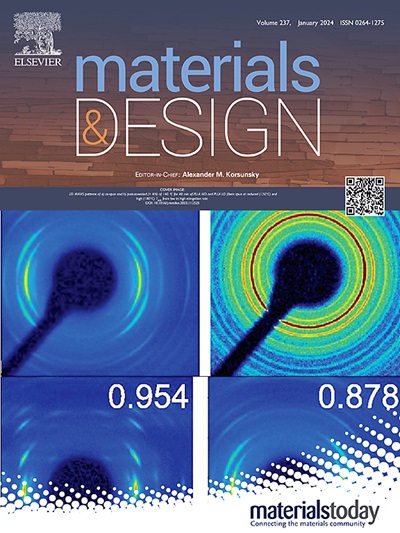Manufacturing and impact resistance of Large-Scale stacked fibre metal laminates
IF 7.6
2区 材料科学
Q1 MATERIALS SCIENCE, MULTIDISCIPLINARY
引用次数: 0
Abstract
This study introduces an automatic manufacturing process for large-scale stacked fibre metal laminates (FMLs) to reduce costs compared to traditional methods. A 3D finite element model was developed using Abaqus/Explicit, incorporating the Johnson─Cook, 3D-Hashin progressive damage, and cohesive surface models to evaluate the impact resistance of the produced FMLs. Charpy and ballistic impact tests validated the model’s accuracy. This study investigates the impact resistance for these conditions. For the Charpy impact, we compared the impact resistance of monolithic aluminium plates, laminated aluminium plates, carbon FMLs, and glass FMLs and observed a progressive increase in energy absorption across these types. Increasing the composite layer thickness shifted the initial failure mode from bottom fracture to shear failure of the middle layer, resulting in decreased energy absorption and increased bending modulus. The influence of the impact angle was examined under ballistic impact, revealing that larger angles resulted in higher energy absorption in cases of complete bullet penetration. Compared to monolithic aluminium plates, large-scale stacked FMLs absorbed less energy but offered significant weight reduction. This study provides a theoretical foundation for optimizing material design and enhancing structural safety.

与传统方法相比,本研究介绍了大规模叠层金属纤维层压板(FML)的自动制造工艺,以降低成本。使用 Abaqus/Explicit 开发了一个三维有限元模型,其中包含 Johnson─Cook、3D-Hashin 渐进损伤和内聚面模型,用于评估生产出的 FML 的抗冲击性。夏比和弹道冲击试验验证了模型的准确性。本研究调查了这些条件下的抗冲击性。在夏比冲击中,我们比较了整体铝板、层压铝板、碳 FML 和玻璃 FML 的抗冲击性,观察到这些类型的能量吸收逐渐增加。复合层厚度的增加使初始破坏模式从底部断裂转变为中间层的剪切破坏,从而导致能量吸收减少和弯曲模量增加。在弹道撞击下,对撞击角度的影响进行了研究,结果表明,在子弹完全穿透的情况下,较大的角度会导致更高的能量吸收。与整体铝板相比,大规模叠层 FML 吸收的能量更少,但重量却显著减轻。这项研究为优化材料设计和提高结构安全性提供了理论基础。
本文章由计算机程序翻译,如有差异,请以英文原文为准。
求助全文
约1分钟内获得全文
求助全文
来源期刊

Materials & Design
Engineering-Mechanical Engineering
CiteScore
14.30
自引率
7.10%
发文量
1028
审稿时长
85 days
期刊介绍:
Materials and Design is a multi-disciplinary journal that publishes original research reports, review articles, and express communications. The journal focuses on studying the structure and properties of inorganic and organic materials, advancements in synthesis, processing, characterization, and testing, the design of materials and engineering systems, and their applications in technology. It aims to bring together various aspects of materials science, engineering, physics, and chemistry.
The journal explores themes ranging from materials to design and aims to reveal the connections between natural and artificial materials, as well as experiment and modeling. Manuscripts submitted to Materials and Design should contain elements of discovery and surprise, as they often contribute new insights into the architecture and function of matter.
 求助内容:
求助内容: 应助结果提醒方式:
应助结果提醒方式:


